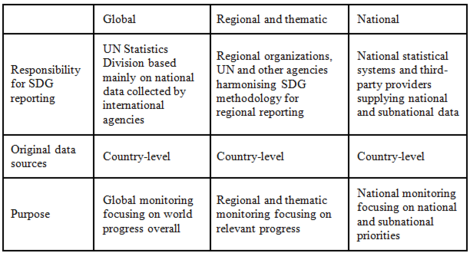This article first appeared on the OECD Development Centre's Development Posts on April 5, 2016. Read it anew here. For comments please contact dev.contact@oecd.org.
After months of intense discussions, representatives from more than 190 national statistical offices agreed on a global monitoring framework for the 2030 Agenda and the Sustainable Development Goals (SDGs). The 17 goals and 169 targets of the framework will be complemented by 230 indicators. This is a huge achievement given the complex political and technical challenges that had to be solved to reach a consensus. Now, the United Nations Economic and Social Council and the United Nations General Assembly formally will endorse the framework. Avoiding a stalemate with this finish line in sight and addressing the framework’s remaining blind spots require urgent attention. The two main points that still need to be addressed are: i) integrating the SDGs into national priorities and strengthening national statistical capacities for that process and ii) improving the indicator set.
Integrating SDGs into national priorities
The following table captures different reporting levels, organizations in the lead and the purpose of the reporting exercises:
SDG monitoring - roles and responsibilities
The relationship between UN technical agencies, such as WHO, UNICEF and FAO, and national governments in the production of statistics is complex. Much of the data we have currently on poverty, health, education or nutrition comes from large-scale international household surveys run by these agencies in countries. This is done in close collaboration with national statistical offices and often includes a capacity-building component that is very useful. However, involving agencies in the production of data can be problematic too as they have their own thematic agenda that might not align with national priorities or could even contradict those priorities. With the heavy SDG agenda, this risk increases substantially and could lead to a crowding out of national capacities.
Another equally important issue is the measurement exercise's purpose. Do we focus all our attention on how best to do global monitoring? Or do we also focus urgently on producing national SDG data roadmaps that identify country-specific baselines, data needs and data filling plans for effective country-level actions? We should not forget that the data are supposed to help policy makers make evidence-based decisions and achieve impact. This happens primarily at national and subnational levels.
Improving the indicators
Even with general agreement on the indicator set, the real work remains. The consensus is clear that the indicators will need to be defined further over the coming months and years. Many indicators are yet to be supported by the required data or methodology. National statistical systems will face trouble with certain indicators or simply will lack the incentives to measure them at all. A good example is indicator 10.5.1 that measures the "financial soundness" of national policies: no government will be motivated to report on this aspect if the country is not doing well, especially given the possible impact on foreign direct investment decisions. Or take indicator 16.4.1 that asks for a country's total value of inward and outward illicit financial flows. Illicit flows by their very nature are clandestine, making only vague estimates possible at best. Another blind spot is the current indicator on corruption: bribery is measured in the public sector whereas the private sector is not considered. Moreover, the indicator set ignores some important problems entirely. Obesity, for example, is not included but is a growing health problem in many middle-income countries, straining public services.
More technical work clearly is needed. But more importantly, the international community needs to provide the financial means to enable national statistical systems to do the job they are asked to do without undermining national priorities and taking into account their current capacity.
Where to go from here
The agenda needs to move now from the global to the national and finally to the local levels. Building partnerships among public institutions - agencies of the national statistical system - citizens and the private sector at the local level is critical. This hopefully will lead to better planning of conventional statistical operations and to building new models that involve citizens, businesses and nongovernmental organisations.
The conclusion is that achieving the SDGs will depend largely on strengthening national and local capacities in a creative synergy of data producers and users. Only then can we hope that policies will be able to reach those who live on the fringes of society. This is how we can leverage data effectively to fulfil the 2030 Agenda's promise to "leave no one behind.''
Follow Johannes Jütting on Twitter: www.twitter.com/Jo_Jutting

